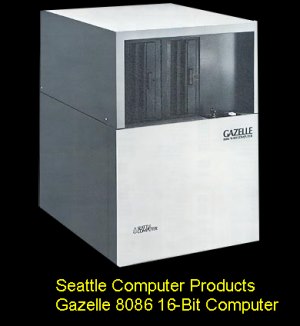
Seattle Computer Products -- History

Seattle computer products (SCP) was located on Industrial
Drive, Seattle, WA., and was founded by Rod Brock in
the mid 1970's. Initially they made S-100 memory boards employing local
Seattle area high-school students to assemble them. They were having
problems with a 16K RAM board at one stage. Rob got to know a guy named Tim
Paterson at a local retail computer store and asked him to fix the design,
which he did quickly. Soon Rib hired Tim on board SCP to chart out board designs for
the company. He quickly laid out a few new RAM boards and then by
chance attended a local seminar on the then new Intel 8086 chip.
He convinced Rob to let him do an S-100 8086 board. He had a layout done in
January 1979 and and had two prototypes going by mid-year. Both Digital Research
(CP/M) and Microsoft (who by this time had moved from Albuquerque to the Seattle
area), were interested in moving their software to the board. Tim with a
guy at Microsoft called Bob O'Rear within a week or two had Microsoft's 32K
basic working with the board.
The board was first shown to the public at the 1979 National Computer Conference
in New York. They showed off their standalone "Basic-86", then the only software
for the 8086. It was a great hit at the show. SCP started shipping
the product with its CPU card in November, primarily to software developers.
Next Tim Paterson began work on a a badly needed 8086 disk operating system.
He was counting on Digital Research coming up with CP/M-86 but there were
delays. This really limited their ability to sell the board -- even to
developers. In the spring of 1980, Tim started working on his own disk
operating system which he originally called QDOS, (for Quick and Dirty DOS).
At the same time Microsoft was working with IBM in trying to place its Basic on
a disk operating platform for the upcoming IBM-PC. The well known saga of the
failure of CP/M and IBM to work together played out for CPM-86. Microsoft
knowing about QDOS realized that it could be quickly, (and IBM issue), hammered
into place as the IBM-PC's disk operating system to run their Basic and other
programs.
Microsoft bought the rights to market QDOS to other manufacturers for $25,000 in
December 1980 relabeling the product "Microsoft DOS". Prior to the IBM-PC
launch, Microsoft bought the full rights to the system for an additional
$50,000.
Realizing that Microsoft was making a significant profit on the DOS operating
system, SCP attempted to sell Seattle DOS with its S-100 8086 CPU board, (which
was allowed as per the marketing agreement with Microsoft) in order to allow SCP
to continue selling the operating system. This operating system was marketed as
"86-DOS", and the CPU was included in the box. The target audience being OEM's.
In May 1981, Tim Peterson left SCP and joined Microsoft itself to work full time
on "PC-DOS" getting it ready for the launch of the IBM-PC in August of that
year. Rob Brock(SCP) and Paul Allen (Microsoft) over the next year
worked out a deal for Microsoft to have total and complete ownership of
86-DOS.
In April 1982 Tim returned to SCP having gotten tired working with IBM in Boca
Raton and its endless stream of bug reports, requests etc. He still had
10% equity in SCP and was thus motivated to see it succeed. He had later left to
set up his own company Falcon Technology (which was later bought by Microsoft).
SCP in the early 80's was expanding its portfolio of S-100 boards and went on to
produce its own 8086 S-100 system the "Gazelle". This quite fancy system had a
S-100 8086, 128K RAM, two 8" drives, a serial/parallel ports card and (unusual
for the S-100 bus) a switching power supply. It has an 18 slot S-100
motherboard. It later had a hard disk controller and hard disk.
Like most S-100 companies however they could never overcome the IBM-PC momentum
though the company lasted well into the 80's.

Seattle Computer Products
S-100 Boards
8086 CPU
8086 Support Board
16K (24-101)RAM
16K (107A)RAM 16KRAM
64KRAM
Serial IO
DiskMaster
This page was last modified
on
01/08/2011



